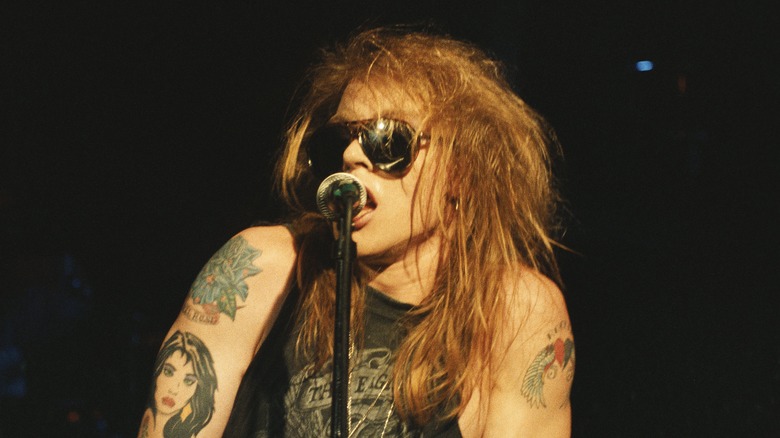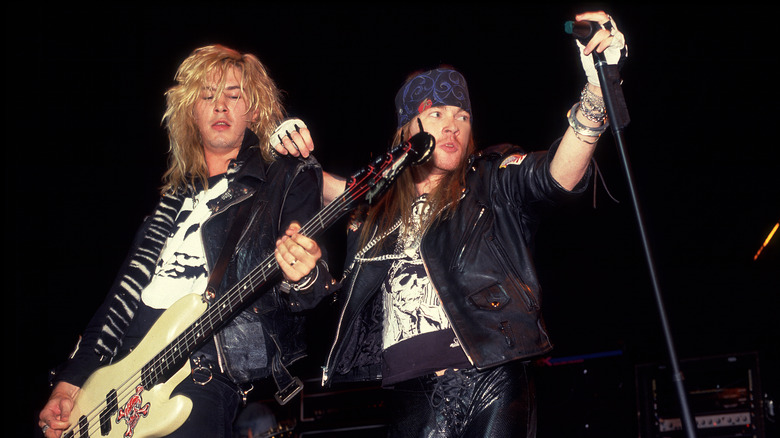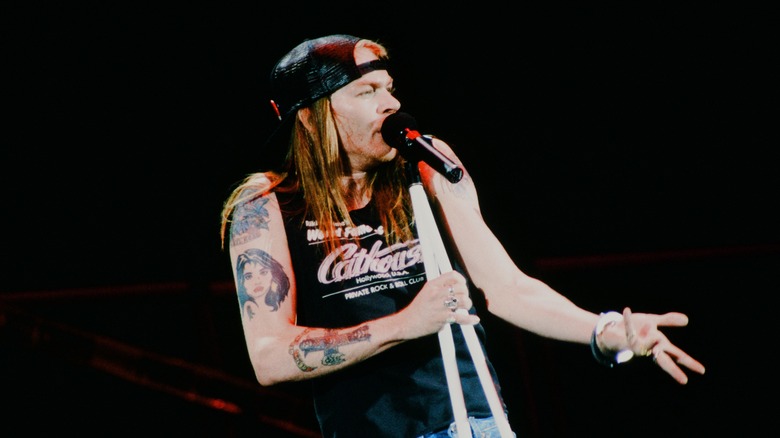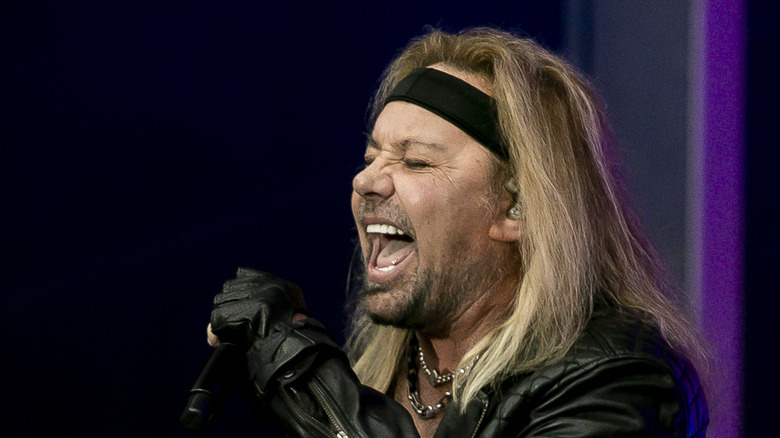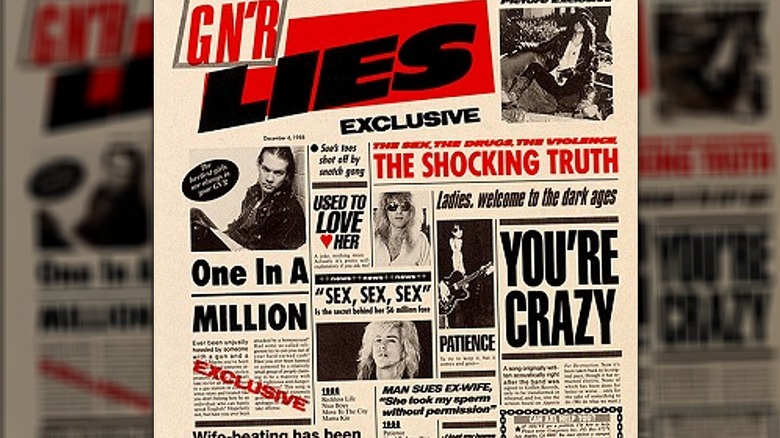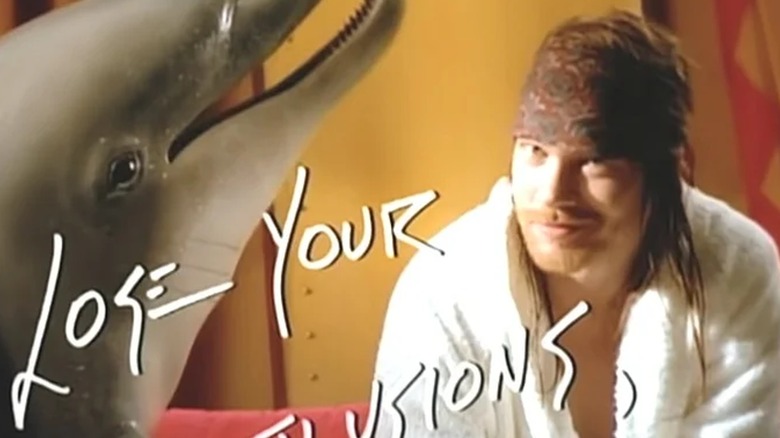Controversial Moments Axl Rose Will Never Live Down
On June 2, 1991, Axl Rose, the lead singer for Guns N' Roses, angry that someone was taking pictures of the concert that night at the Riverport Arena, jumped off the stage and began pummeling the man. Afterward, Rose, angry at the security guards, decided to end the show in a suburb of St. Louis, Missouri. "Thanks to the lame-ass security, I'm going home!," he shouted before storming off stage (via Rolling Stone). The rest of the band followed him and a full-scale riot by fans ensued, along with criminal charges for Rose.
At the time, Guns N' Roses had reached international stardom with hits like "Sweet Child O' Mine" and "Welcome to the Jungle" but with the global success came the lead singer's escalating erratic behavior. While the riot was one of the biggest moments Rose will never live down, there are many more, from feuds with fellow rockers like Vince Neil to a fistfight with David Bowie. All this bad behavior meant Axl Rose had been arrested a lot, as in the double digits. But beyond this, there were other ignominious moments for Rose, from his defense of racist song lyrics to a bizarre music video involving a dolphin.
Inciting riots
The June 2, 1991 riot that Axl Rose kicked off by attacking a fan and then bailing ended with 65 people getting hurt and $300,000 in damage to the venue and the band's equipment, per Dayton Daily News. While Rose was charged with several crimes, he got off with a hefty fine and probation. It was one of two riots Rose helped incite that summer during Guns N' Roses' world tour to promote the upcoming release of their massive hit double album "Use Your Illusion 1 & 2" on September 17, 1991. The other took place two months later in Montreal, in which the band went on stage two hours late and ended the show early. The second riot caused $400,000 in damage before spilling out into the city's streets where crazed fans smashed windows, set fires, and looted stores.
"Every gig after Riverport, the threat of violence hung in the air — or at least it felt that way to me as I sat around stewing, waiting for our singer to turn up each night, listening nervously for the festive noise of the arena to transform into the low rumble of a big, angry crowd," Duff McKagen, the band's bassist, recalled in his memoir "It's So Easy: And Other Lies."
No show and super slow
Duff McKagen's recollection hits not only on Axl Rose's violent behavior towards the audience but another of the lead singer's glaring faults. Rose had a reputation for being late to gigs or in the case of an October 1986 show opening for Alice Cooper, he didn't show up at all. The most egregious no-show of Rose's career may have been not making it to the band's induction to the Rock & Roll Hall of Fame in 2012.
Rose's lax attitude concerning timeliness may have bled over into the production side. Another moment, or — more accurately — long, long series of moments that the singer will never live down was the long-delayed release of the GN'R's album "Chinese Democracy." The bloated budget, estimated at $14 million, was matched by the number of studios, musicians, and production staff involved (more than a dozen of each). The album that failed to wow critics or fans, took 11 years to make.
Feuding, fussing, and fighting
Axl Rose's temper has led him into numerous spats not only with his former bandmates but with other musicians, journalists, and actors. Besides punching David Bowie for paying too much attention to Rose's girlfriend, there was the feud between Guns N' Roses and Vince Neil of Mötley Crüe that didn't get much farther than name-calling and threats. "Vince, whichever way you want it, man: Guns, knives or fists, whatever you want to do. I don't care," Rose said through the press. When Neil responded by trying to set up a televised fight between them, Rose demurred.
In 1992 alone, Rose verbally abused the actor Warren Beatty from a Paris stage and threatened Nirvana's lead singer Kurt Kobain at the MTV Video Music Awards. Rose also wrote a song "Get in the Ring" for "Use Your Illusion II" in which he invited certain members of the media to fight him, including Bob Guccione Jr., the publisher of Spin magazine. When Guccione called his bluff, Rose once again backed down. "I was very happy the fight never happened because I was so much bigger and stronger than him it wouldn't have ended well," Guccione told Appetite for Distortion (via YouTube). "He did not know ... that I was a very accomplished full-contact fighter."
Defending his racist slurs
After the November 1988 release of "G N' R Lies," Guns N' Roses' second studio album, the shocking lyrics of "One in a Million," in which Axl Rose uses racist and homophobic slurs and anti-immigrant rhetoric, he doubled down. During an interview with Rolling Stone in August 1989, he groused that it wasn't fair that Blacks could use a racial epithet with each other but when "a white guy does it all of a sudden it's a big put-down.” He then went on to say he meant the word to describe "somebody that is basically a pain in your life, a problem."
When describing his homophobic and anti-immigrant language in the song, he chalked it up to "very bad experiences" he'd had with these groups, which, as The New York Times pointed out were "classic examples of bigoted illogic, which extrapolates from individuals to demonize whole groups." Rose's lame excuses for his prejudiced lyrics didn't fly. Besides the Times, everyone from actor and talk-show host Arsenio Hall to singer Boy George came out against the song.
The weird dolphin video
Besides Axl Rose's confrontational attitude and racist rhetoric, he also has a litany of strange and embarrassing behavior that may be less egregious but is by no means run of the mill. There is the cornrow hairstyle he once sported, his odd clothing choices, and the head-scratching ending he scripted for Guns N' Roses strangest music video that involved a breakup between the singer and his girlfriend.
In the early 2000s, Rose wore cornrows, a traditionally Black hairstyle, which, given his earlier use of racist language, had some seeing red (which happened to be the color of his braids). This wasn't the only sartorial faux pas for which the singer has been cited. There was the time he wore a T-shirt featuring convicted mass murderer Charles Manson (relatedly, Guns N' Roses got even more flack for including a Manson-penned song on their covers album "The Spaghetti Incident"). Perhaps the weirdest moment Rose will never live down was the ending of the video "Estranged," in which he's shown with a dolphin wearing a plaid outfit (the dolphin, not Rose). Rose said the dolphin represented "a state of peace" via Kerrang!, and the video was his "conceptual way" of dealing with his breakup with supermodel Stephanie Seymour, according to "Goodbye Guns N' Roses: The Crime, Beauty, and Amplified Chaos of America's Most Polarizing Band.
